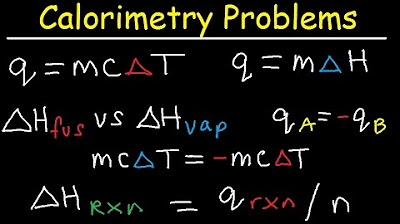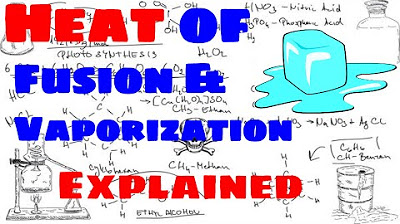Chilling water problem | States of matter and intermolecular forces | Chemistry | Khan Academy
TLDRIn this educational video, the presenter explores the concept of phase change by calculating the amount of ice needed to cool 500 grams of water from 60 degrees Celsius to zero degrees Celsius. Using the specific heat capacities of water and ice, along with the heat of fusion, the presenter demonstrates that only 354.02 grams of ice at -10 degrees Celsius are required to achieve the goal. The explanation highlights the significant energy absorption capacity of ice during melting, which allows a smaller mass of ice to cool a larger mass of water effectively.
Takeaways
- 🧊 The problem involves cooling 500 grams of water from 60°C to 0°C using ice made at -10°C.
- 🔍 The process requires understanding heat transfer between water and ice to achieve the desired temperature change.
- ❄️ Ice absorbs heat from the water, which is initially at 60°C, and the ice's temperature will rise from -10°C.
- 🔢 The specific heat capacity of water is used to calculate the amount of heat that needs to be extracted (4.178 J/g·K).
- ♻️ A 50°C temperature change for the water means a significant amount of heat must be removed or added, calculated as 125,340 joules.
- 🧊 The ice's heat absorption capacity is determined by its specific heat (2.05 J/g·K) and the heat of fusion (333.55 J/g).
- 📈 The total heat the ice can absorb without exceeding 0°C is the sum of heat absorbed during the temperature rise and melting.
- 🔑 The variable x represents the unknown mass of ice needed, which is calculated to be 354.02 grams to cool the water effectively.
- 📚 The calculation involves algebraic manipulation to equate the heat absorbed by the ice to the heat that needs to be removed from the water.
- 🤔 The surprising result is that less ice by mass is needed compared to the water, highlighting the efficiency of the phase change in heat absorption.
- ✨ The explanation emphasizes the concept of latent heat during the phase change from ice to water, which plays a crucial role in the cooling process.
Q & A
What is the goal of the problem presented in the script?
-The goal is to determine the exact amount of ice needed to cool 500 grams of liquid water at 60 degrees Celsius down to 0 degrees Celsius.
What is the initial temperature of the water in the problem?
-The initial temperature of the water is 60 degrees Celsius.
What is the initial temperature of the ice produced by the ice machine?
-The ice machine produces ice at an initial temperature of minus 10 degrees Celsius.
What is the specific heat capacity of water used in the calculations?
-The specific heat capacity of water used in the calculations is 4.178 joules per gram Kelvin.
How much heat in joules is required to cool 500 grams of water from 60 degrees Celsius to 0 degrees Celsius?
-The amount of heat required is 125,340 joules.
What is the specific heat capacity of ice used in the calculations?
-The specific heat capacity of ice used is 2.05 joules per gram Kelvin.
What is the heat of fusion for ice?
-The heat of fusion for ice is 333.55 joules per gram.
How much total heat can the ice absorb without going above 0 degrees Celsius?
-The total heat the ice can absorb without going above 0 degrees Celsius is the sum of the heat absorbed warming from -10 degrees Celsius to 0 degrees Celsius and the heat of fusion, which is 20.5x + 333.55x joules, where x is the mass of the ice in grams.
What is the calculated amount of ice needed in grams to cool the water to 0 degrees Celsius?
-The calculated amount of ice needed is approximately 354.02 grams.
Why is it important for the ice not to exceed 0 degrees Celsius during the process?
-It is important because if the ice exceeds 0 degrees Celsius, it will start to warm up and will no longer be able to absorb heat effectively to cool the water down to 0 degrees Celsius.
What is the significance of the heat of fusion in this problem?
-The heat of fusion is significant because it represents the amount of energy the ice can absorb while transitioning from a solid state to a liquid state at 0 degrees Celsius without changing its temperature, which is crucial for cooling the water.
Outlines
🧊 Cooling Water with Ice: A Phase Change Calculation
In this paragraph, the script discusses a phase change problem involving cooling 500 grams of liquid water from 60 degrees Celsius to zero degrees Celsius using ice initially at minus 10 degrees Celsius. The main focus is on calculating the exact amount of ice required to achieve this temperature drop. The process involves understanding heat transfer, where the heat from the warmer water is absorbed by the colder ice. The script explains the need to calculate the energy required to cool the water and the energy the ice can absorb before melting. It introduces the specific heat capacity of water and ice, and the heat of fusion for ice, leading to a formula to determine the necessary amount of ice.
🔢 Mathematical Solution to the Ice-Water Cooling Problem
This paragraph delves into the mathematical aspect of the problem introduced earlier. It outlines the steps to calculate the total heat that needs to be absorbed by the ice to cool the water to zero degrees Celsius. The script sets up an equation using the specific heat capacity of ice and the heat of fusion, and then solves for the variable representing the amount of ice needed. The calculation shows that the ice must absorb a total of 125,340 joules of energy without exceeding zero degrees Celsius. Through algebraic manipulation, the script arrives at the conclusion that approximately 354 grams of ice are required to cool the 500 grams of water, emphasizing the surprising efficiency of this process.
🤔 Reflecting on the Cooling Process and Energy Absorption
The final paragraph reflects on the outcome of the calculation, discussing the surprising result that less ice is needed compared to the amount of water being cooled. It highlights the intuitive misconception that a large amount of ice would be required for such a task. The script explains the reason behind this outcome, which is the significant amount of energy that can be absorbed by ice as it melts, without a change in temperature. This energy absorption, known as the heat of fusion, plays a crucial role in the efficiency of the cooling process, allowing a relatively small amount of ice to cool a larger volume of water significantly.
Mindmap
Keywords
💡Phase Change
💡Specific Heat
💡Heat of Fusion
💡Latent Heat
💡Temperature Differential
💡Joules
💡Ice Machine
💡Thermodynamics
💡Energy Transfer
💡Melting
💡Heat Absorption
Highlights
A phase change problem involving cooling 500 grams of water from 60 degrees Celsius to zero degrees Celsius using ice.
The ice machine produces ice at minus 10 degrees Celsius.
Heat transfer from water to ice is the key to the cooling process.
Calculating the energy required to cool the water using the specific heat of water.
The specific heat of water is 4.178 joules per gram Kelvin.
A 50-degree temperature change for the water requires a specific amount of energy to be extracted.
The total heat to be extracted from the water is calculated to be 125,340 joules.
The ice absorbs energy as it warms from minus 10 to zero degrees Celsius.
The specific heat of ice is 2.05 joules per gram Kelvin.
The energy absorbed by the ice as it warms is calculated to be 20.5 times the mass of the ice.
The heat of fusion of ice is 333.55 joules per gram, allowing the ice to absorb more energy as it melts.
The total heat the ice can absorb without exceeding zero degrees Celsius is the sum of warming and melting energies.
The algebraic equation to find the mass of ice needed is set up using the total heat absorbed by the ice.
Solving the equation yields approximately 354 grams of ice needed to cool the water.
The surprising result is that less ice by mass is required than water to achieve the cooling.
The energy absorbed by the ice is primarily due to the heat of fusion during melting.
The practical application of this problem demonstrates the efficiency of using ice for cooling.
Transcripts
Browse More Related Video

Specific heat, heat of fusion and vaporization example | Chemistry | Khan Academy

Calorimetry Problems, Thermochemistry Practice, Specific Heat Capacity, Enthalpy Fusion, Chemistry

Latent Heat of Fusion and Vaporization, Specific Heat Capacity & Calorimetry - Physics

Entropy Change For Melting Ice, Heating Water, Mixtures & Carnot Cycle of Heat Engines - Physics

How Much Thermal Energy Is Required To Heat Ice Into Steam - Heating Curve Chemistry Problems

Heat of Fusion and Heat of Vaporization Explained
5.0 / 5 (0 votes)
Thanks for rating: